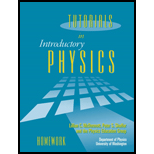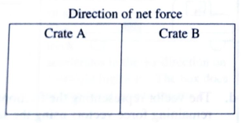
Concept explainers
As the elevator approach its destination, its speed decreases. (It continues to move downward.)
i. How does the acceleration of crate A compare to that of crate B? Explain.
ii. In the spaces provided below, draw and label separate free-body diagram for the crates in this case.

iii. Rank the forces on the crates according to magnitude, from largest to smallest. Explain your reasoning, including how you used
iv. In the spaces provided at right, draw arrows to indicate the direction of the net force on each crate. If the net force on either crate is zero, state so explicitly. Explain.

Is the magnitude of the net force acting on crate Agreater than, less than, or equal to that on crate B? Explain.
Want to see the full answer?
Check out a sample textbook solution
Chapter 16 Solutions
Tutorials In Introductory Physics: Homework
Additional Science Textbook Solutions
College Physics
University Physics with Modern Physics (14th Edition)
Essential University Physics: Volume 2 (3rd Edition)
College Physics: A Strategic Approach (4th Edition)
Essential University Physics (3rd Edition)
The Cosmic Perspective Fundamentals (2nd Edition)
- 1. Your free body diagram for Part 1 should have looked it this. F. max Drag and drop the heads and tails of the vectors to construct the free-body diagram. Note: the applied force is directed to the right. Note: the angles may be within ±15°, and the magnitudes are not considered. = Suppose you have a 120-kg wooden crate resting on a wood floor. Use µg = 0.5 and μ = 0.3 . Assume all quantities are correct to 3 significant figures. a = 1.96 ffric; 180° (b) What is the maximum force you can exert horizontally on the crate without moving it? Enter to 3 significant figures ✔N N: 90° a m/s² mg; 270° F:0° (c) If you continue to exert this force once the crate starts to slip, what will its acceleration then be? Enter to 3 significant figuresarrow_forwardPlease solve the problem below. Explain your reasoning behind every step to solve the problem.arrow_forwardIgnoring friction, explain what would occur in the following situation and how it relates to Newton’s Third law. a. A cannon shoots out a cannon ball. Draw and label the action and reaction forces between the cannon and cannonball. b. How does the cannon's acceleration compare to the cannon ball and why?arrow_forward
- Two masses B and C are connected with a string passing over a friction less pully, assuming the coefficient of friction between the table and block is μ=0.4 , and the acceleration of gravity g=9.81 m/s2. Solve the following questions (show all the steps of your calculations): A. Draw the free body diagram of the two masses.B. Find an expression of the acceleration of the two masses in terms of ?? and ??.C. Determine the tension in the rope in terms of ?? and ??.D. If ??= ʎ kg, ?? = (ʎ-5) kg, determine the acceleration of two blocks and the tension in the rope.(ʎ= the final two numbers of your ID +10, and, gravitational acceleration, g = 9.81 m/s2).arrow_forwardhow to solve?arrow_forwardPls. provide a right answer and complete solution.arrow_forward
- 2. Consider the three masses connected as shown below. The inclined plane makes an angle 0 with the horizontal and the coefficient of kinetic friction for all surfaces is pa. The pullies are massless and frictionless. The mass m, moves downward as shown. Answer the following questions. a) Draw the free body diagrams for cach of the masses. b) Apply Newton's second law to each of the masses. DO NOT solve the equations yet. Just set them up. c) Solve your equations in part b) for the acceleration of the system. Your expression for the acceleration should only contain mi, m2, m3, 0, pk, and various constants.arrow_forwardPlease question 2 with its sub-section.arrow_forwardFull steps to the parts pleasearrow_forward
- Please Asaparrow_forwardCompare and contrast the dynamics of a cyclist riding along a velodrome track at a constant speed, to one who is freely rolling down the track/ramp (no friction). a. Construct free-body diagrams for each situation (angle = ɵ). b. Draw a “dotted arrow” showing the direction of acceleration for each case on the FBD. c. Starting with FNET=ma (in the direction of “a”), determine an equation for “a” for each.arrow_forward4. A 10 kg block on a level surface is pushed by a 50 N force directed 30 degrees below the horizontal (like this: ). The coefficient of static friction between the block and the surface is 0.60 and the coefficient of kinetic friction is 0.40. a. Does the block slide or stay put? Justify your answer with a calculation. b. If it slides, calculate its acceleration. If it stays put, calculate the friction force acting on the block. Show your work.arrow_forward
 College PhysicsPhysicsISBN:9781305952300Author:Raymond A. Serway, Chris VuillePublisher:Cengage Learning
College PhysicsPhysicsISBN:9781305952300Author:Raymond A. Serway, Chris VuillePublisher:Cengage Learning University Physics (14th Edition)PhysicsISBN:9780133969290Author:Hugh D. Young, Roger A. FreedmanPublisher:PEARSON
University Physics (14th Edition)PhysicsISBN:9780133969290Author:Hugh D. Young, Roger A. FreedmanPublisher:PEARSON Introduction To Quantum MechanicsPhysicsISBN:9781107189638Author:Griffiths, David J., Schroeter, Darrell F.Publisher:Cambridge University Press
Introduction To Quantum MechanicsPhysicsISBN:9781107189638Author:Griffiths, David J., Schroeter, Darrell F.Publisher:Cambridge University Press Physics for Scientists and EngineersPhysicsISBN:9781337553278Author:Raymond A. Serway, John W. JewettPublisher:Cengage Learning
Physics for Scientists and EngineersPhysicsISBN:9781337553278Author:Raymond A. Serway, John W. JewettPublisher:Cengage Learning Lecture- Tutorials for Introductory AstronomyPhysicsISBN:9780321820464Author:Edward E. Prather, Tim P. Slater, Jeff P. Adams, Gina BrissendenPublisher:Addison-Wesley
Lecture- Tutorials for Introductory AstronomyPhysicsISBN:9780321820464Author:Edward E. Prather, Tim P. Slater, Jeff P. Adams, Gina BrissendenPublisher:Addison-Wesley College Physics: A Strategic Approach (4th Editio...PhysicsISBN:9780134609034Author:Randall D. Knight (Professor Emeritus), Brian Jones, Stuart FieldPublisher:PEARSON
College Physics: A Strategic Approach (4th Editio...PhysicsISBN:9780134609034Author:Randall D. Knight (Professor Emeritus), Brian Jones, Stuart FieldPublisher:PEARSON





